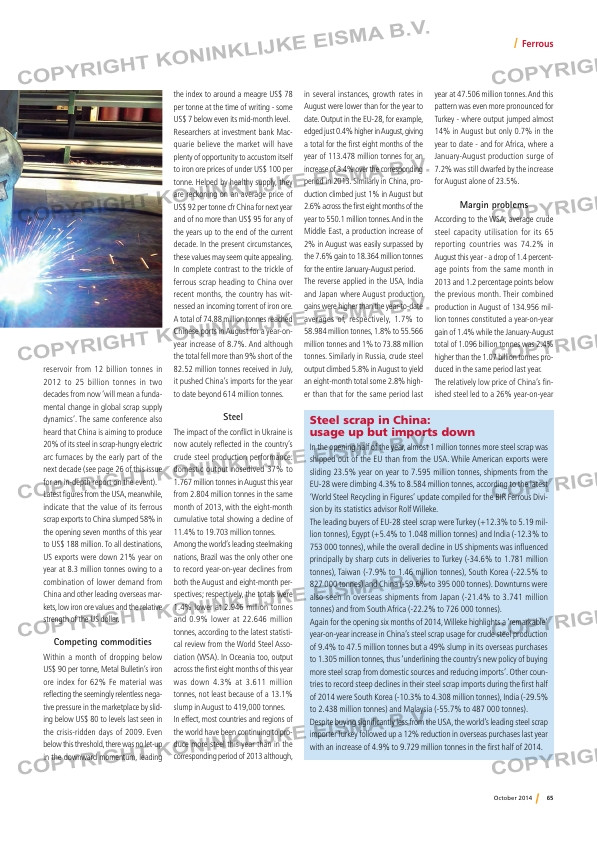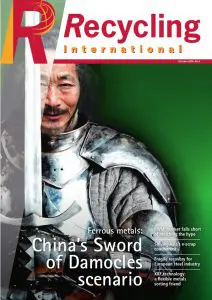Page 65 from: October 2014

65October 2014
Ferrous
reservoir from 12 billion tonnes in
2012 to 25 billion tonnes in two
decades from now ‘will mean a funda-
mental change in global scrap supply
dynamics’. The same conference also
heard that China is aiming to produce
20% of its steel in scrap-hungry electric
arc furnaces by the early part of the
next decade (see page 26 of this issue
for an in-depth report on the event).
Latest figures from the USA, meanwhile,
indicate that the value of its ferrous
scrap exports to China slumped 58% in
the opening seven months of this year
to US$ 188 million. To all destinations,
US exports were down 21% year on
year at 8.3 million tonnes owing to a
combination of lower demand from
China and other leading overseas mar-
kets, low iron ore values and the relative
strength of the US dollar.
Competing commodities
Within a month of dropping below
US$ 90 per tonne, Metal Bulletin’s iron
ore index for 62% Fe material was
reflecting the seemingly relentless nega-
tive pressure in the marketplace by slid-
ing below US$ 80 to levels last seen in
the crisis-ridden days of 2009. Even
below this threshold, there was no let-up
in the downward momentum, leading
the index to around a meagre US$ 78
per tonne at the time of writing – some
US$ 7 below even its mid-month level.
Researchers at investment bank Mac-
quarie believe the market will have
plenty of opportunity to accustom itself
to iron ore prices of under US$ 100 per
tonne. Helped by healthy supply, they
are reckoning on an average price of
US$ 92 per tonne cfr China for next year
and of no more than US$ 95 for any of
the years up to the end of the current
decade. In the present circumstances,
these values may seem quite appealing.
In complete contrast to the trickle of
ferrous scrap heading to China over
recent months, the country has wit-
nessed an incoming torrent of iron ore.
A total of 74.88 million tonnes reached
Chinese ports in August for a year-on-
year increase of 8.7%. And although
the total fell more than 9% short of the
82.52 million tonnes received in July,
it pushed China’s imports for the year
to date beyond 614 million tonnes.
Steel
The impact of the conflict in Ukraine is
now acutely reflected in the country’s
crude steel production performance:
domestic output nosedived 37% to
1.767 million tonnes in August this year
from 2.804 million tonnes in the same
month of 2013, with the eight-month
cumulative total showing a decline of
11.4% to 19.703 million tonnes.
Among the world’s leading steelmaking
nations, Brazil was the only other one
to record year-on-year declines from
both the August and eight-month per-
spectives; respectively, the totals were
1.4% lower at 2.946 million tonnes
and 0.9% lower at 22.646 million
tonnes, according to the latest statisti-
cal review from the World Steel Asso-
ciation (WSA). In Oceania too, output
across the first eight months of this year
was down 4.3% at 3.611 million
tonnes, not least because of a 13.1%
slump in August to 419,000 tonnes.
In effect, most countries and regions of
the world have been continuing to pro-
duce more steel this year than in the
corresponding period of 2013 although,
in several instances, growth rates in
August were lower than for the year to
date. Output in the EU-28, for example,
edged just 0.4% higher in August, giving
a total for the first eight months of the
year of 113.478 million tonnes for an
increase of 3.4% over the corresponding
period in 2013. Similarly in China, pro-
duction climbed just 1% in August but
2.6% across the first eight months of the
year to 550.1 million tonnes. And in the
Middle East, a production increase of
2% in August was easily surpassed by
the 7.6% gain to 18.364 million tonnes
for the entire January-August period.
The reverse applied in the USA, India
and Japan where August production
gains were higher than the year-to-date
averages of, respectively, 1.7% to
58.984 million tonnes, 1.8% to 55.566
million tonnes and 1% to 73.88 million
tonnes. Similarly in Russia, crude steel
output climbed 5.8% in August to yield
an eight-month total some 2.8% high-
er than that for the same period last
year at 47.506 million tonnes. And this
pattern was even more pronounced for
Turkey – where output jumped almost
14% in August but only 0.7% in the
year to date – and for Africa, where a
January-August production surge of
7.2% was still dwarfed by the increase
for August alone of 23.5%.
Margin problems
According to the WSA, average crude
steel capacity utilisation for its 65
reporting countries was 74.2% in
August this year – a drop of 1.4 percent-
age points from the same month in
2013 and 1.2 percentage points below
the previous month. Their combined
production in August of 134.956 mil-
lion tonnes constituted a year-on-year
gain of 1.4% while the January-August
total of 1.096 billion tonnes was 2.4%
higher than the 1.07 billion tonnes pro-
duced in the same period last year.
The relatively low price of China’s fin-
ished steel led to a 26% year-on-year
In the opening half of the year, almost 1 million tonnes more steel scrap was
shipped out of the EU than from the USA. While American exports were
sliding 23.5% year on year to 7.595 million tonnes, shipments from the
EU-28 were climbing 4.3% to 8.584 million tonnes, according to the latest
‘World Steel Recycling in Figures’ update compiled for the BIR Ferrous Divi-
sion by its statistics advisor Rolf Willeke.
The leading buyers of EU-28 steel scrap were Turkey (+12.3% to 5.19 mil-
lion tonnes), Egypt (+5.4% to 1.048 million tonnes) and India (-12.3% to
753 000 tonnes), while the overall decline in US shipments was influenced
principally by sharp cuts in deliveries to Turkey (-34.6% to 1.781 million
tonnes), Taiwan (-7.9% to 1.46 million tonnes), South Korea (-22.5% to
827 000 tonnes) and China (-59.6% to 395 000 tonnes). Downturns were
also seen in overseas shipments from Japan (-21.4% to 3.741 million
tonnes) and from South Africa (-22.2% to 726 000 tonnes).
Again for the opening six months of 2014, Willeke highlights a ‘remarkable’
year-on-year increase in China’s steel scrap usage for crude steel production
of 9.4% to 47.5 million tonnes but a 49% slump in its overseas purchases
to 1.305 million tonnes, thus ‘underlining the country’s new policy of buying
more steel scrap from domestic sources and reducing imports’. Other coun-
tries to record steep declines in their steel scrap imports during the first half
of 2014 were South Korea (-10.3% to 4.308 million tonnes), India (-29.5%
to 2.438 million tonnes) and Malaysia (-55.7% to 487 000 tonnes).
Despite buying significantly less from the USA, the world’s leading steel scrap
importer Turkey followed up a 12% reduction in overseas purchases last year
with an increase of 4.9% to 9.729 million tonnes in the first half of 2014.
Steel scrap in China:
usage up but imports down
RI8-Analysis Ferrous.indd 65 06-10-14 15:16



